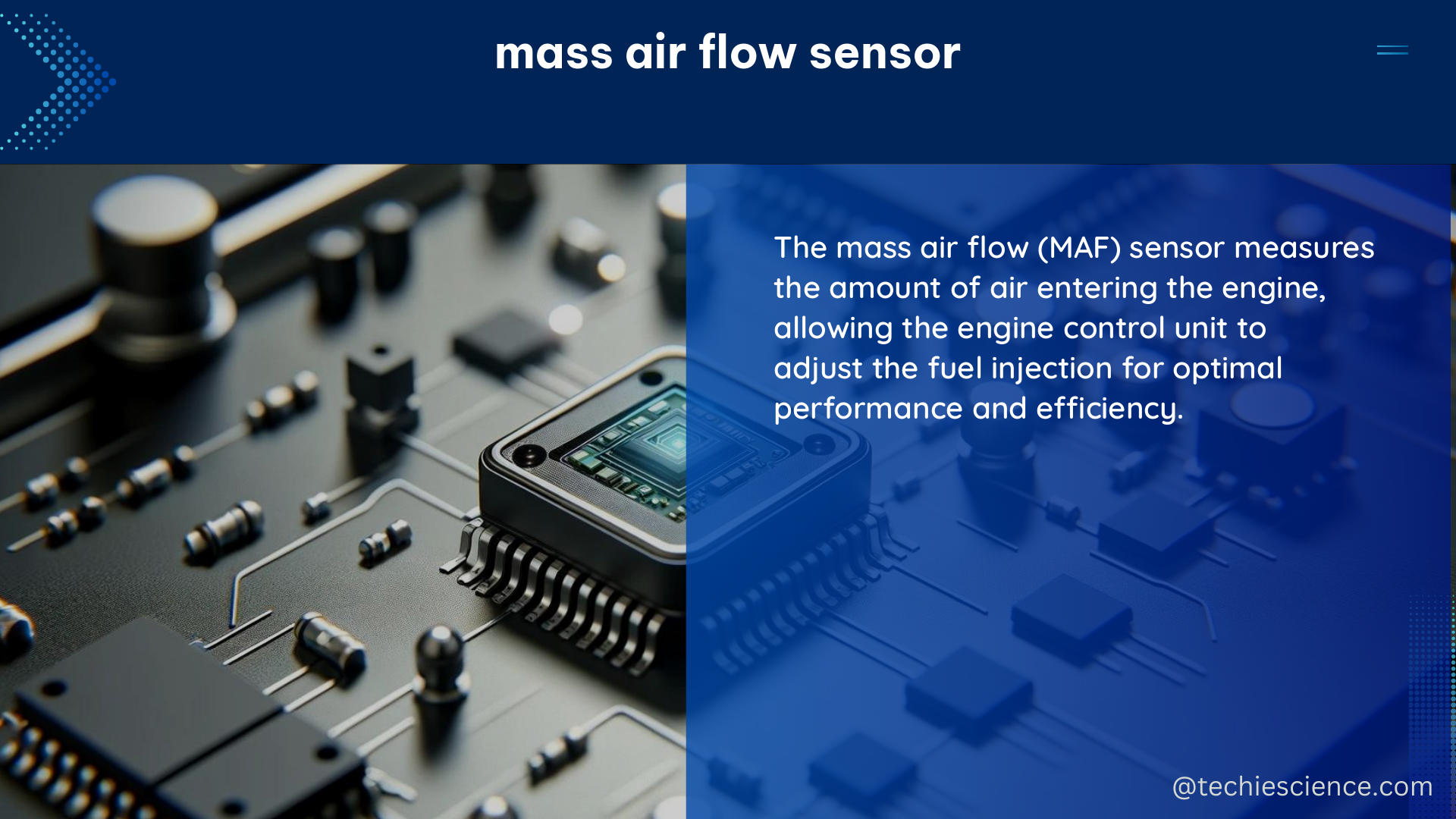The mass air flow (MAF) sensor is a critical component in modern internal combustion engines, responsible for precisely measuring the mass flow rate of air entering the engine. This data is essential for the engine control unit (ECU) to calculate the correct amount of fuel to inject, ensuring optimal engine performance and reduced emissions.
Understanding the Principles of MAF Sensors
MAF sensors rely on various physical principles to measure airflow. One of the most common methods is the use of a heated element, such as a platinum resistor, which is maintained at a constant temperature. As air flows past the heated element, it cools the resistor, causing its resistance to change. This resistance change is then converted into a voltage or frequency signal, which can be interpreted by the ECU.
Another common MAF sensor design utilizes a thin-film anemometer, where a heated thin-film element is exposed to the airflow. The cooling of this element is proportional to the mass flow rate of the air, and this change in temperature is measured and converted into an electrical signal.
Decoding the Technical Specifications of MAF Sensors

The technical specifications of a MAF sensor can vary significantly depending on the manufacturer and application. Let’s take a closer look at the Delphi Mass Air Flow Sensor (Part # AF10043) as an example:
| Specification | Value |
|---|---|
| Voltage Output Range | 0-5V |
| Temperature Range | -40°C to 125°C |
| Airflow Measurement Range | 0-200 g/s |
| Accuracy | ±1.5% of reading |
| Response Time | < 10 ms |
| Supply Voltage | 8-16V |
| Power Consumption | < 1W |
Understanding these technical specifications is crucial when working with MAF sensors, particularly in DIY applications. For instance, if you’re using a data acquisition (DAQ) device to measure the output signal of a MAF sensor, you’ll need to ensure that the DAQ device is compatible with the sensor’s output signal type (voltage, frequency, or PWM) and has the necessary resolution and accuracy to capture the sensor’s full range of measurements.
Interpreting the MAF Sensor’s Output Signal
The output signal from a MAF sensor can take various forms, depending on the sensor design. The most common types are:
- Voltage Output: The sensor outputs a voltage signal proportional to the airflow rate, typically in the range of 0-5V or 0-12V.
- Frequency Output: The sensor outputs a frequency signal that varies with the airflow rate, typically in the range of 0-1 kHz.
- Pulse Width Modulation (PWM) Output: The sensor outputs a PWM signal, where the duty cycle is proportional to the airflow rate.
When working with a MAF sensor, it’s essential to understand the specific output signal type and how to interpret the data. For example, if you’re using a voltage output MAF sensor, you’ll need to calibrate your measurement system to convert the voltage signal into a meaningful airflow rate value.
Integrating MAF Sensors into DIY Applications
In DIY applications, such as engine tuning or custom engine management systems, integrating a MAF sensor can be a complex task. You’ll need to consider factors like sensor placement, signal conditioning, and data processing to ensure accurate and reliable measurements.
One important consideration is the sensor’s mounting location. The MAF sensor should be positioned in a straight section of the intake system, away from any bends or obstructions that could disrupt the airflow and affect the sensor’s readings. Proper sensor placement is crucial for obtaining accurate airflow data.
Additionally, you may need to implement signal conditioning circuitry to ensure the sensor’s output signal is compatible with your data acquisition system. This may involve amplification, filtering, or analog-to-digital conversion, depending on the specific requirements of your setup.
Troubleshooting and Maintenance of MAF Sensors
Like any automotive component, MAF sensors can experience issues over time, such as sensor drift, contamination, or failure. Regular maintenance and troubleshooting are essential to ensure the sensor’s continued performance and reliability.
One common issue with MAF sensors is the buildup of deposits on the sensing element, which can affect the sensor’s accuracy. Periodic cleaning of the sensor, following the manufacturer’s recommendations, can help maintain its performance.
In the event of a suspected MAF sensor issue, it’s important to use the appropriate diagnostic tools and techniques to identify the problem. This may involve using an OBD2 scanner to read diagnostic trouble codes, or performing direct measurements of the sensor’s output signal to verify its operation.
Conclusion
The mass air flow sensor is a critical component in modern internal combustion engines, providing essential data for the engine control unit to optimize fuel delivery and emissions. By understanding the principles, technical specifications, and integration considerations of MAF sensors, you can ensure accurate and reliable airflow measurements in your DIY applications, ultimately leading to improved engine performance and efficiency.
References:
– Pagonis, D.-N., Benaki, V., Kaltsas, G., & Pagonis, A. (2021). Design of a Mass Air Flow Sensor Employing Additive Manufacturing and Standard Airfoil Geometry. Applied Sciences, 11(24), 11579.
– How to Test a MAF (Mass Airflow) Sensor with a Low-Cost OBD2 Scan Tool. (2023, March 12). Retrieved from https://www.backyardmechanic.org/2-ways-test-a-maf-sensor-with-a-low-cost-scan-tool/
– How Do Mass Air Flow Sensors Work? – Servoflo. (2021, January 14). Retrieved from http://blog.servoflo.com/how-do-mass-air-flow-sensors-work
– Delphi Mass Air Flow Sensor – AF10043. (n.d.). Retrieved from https://shop.advanceautoparts.com/p/delphi-mass-air-flow-sensor-af10043/20973820-p
– MASS AIRFLOW SENSOR SIGNAL PROCESSING METHOD. (2017, August 24). Retrieved from https://www.freepatentsonline.com/y2017/0241383.html

The lambdageeks.com Core SME Team is a group of experienced subject matter experts from diverse scientific and technical fields including Physics, Chemistry, Technology,Electronics & Electrical Engineering, Automotive, Mechanical Engineering. Our team collaborates to create high-quality, well-researched articles on a wide range of science and technology topics for the lambdageeks.com website.
All Our Senior SME are having more than 7 Years of experience in the respective fields . They are either Working Industry Professionals or assocaited With different Universities. Refer Our Authors Page to get to know About our Core SMEs.